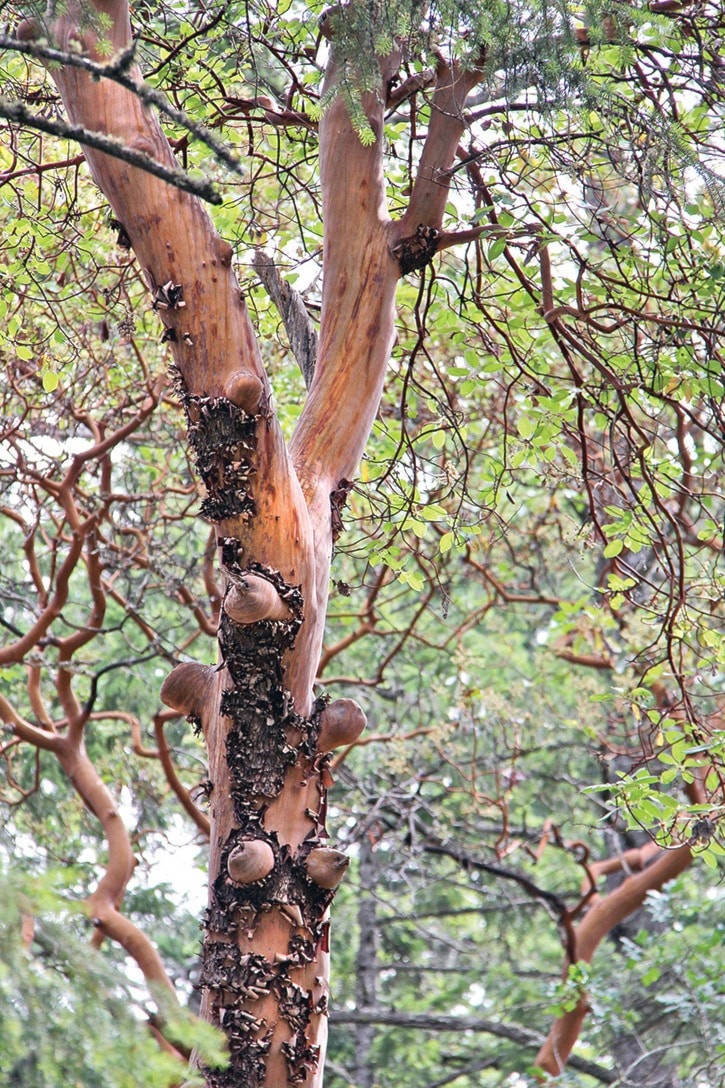Spring has sprung. The clocks have been reset to give us an extra hour of daylight – possibly getting us outside in the wild a bit more often for a bit longer periods of time.
One of the things you may notice while you’re out in the wonders of nature around the West Shore is fungus, particularly on the arbutus trees around. You may even have a few in your yard you’re wondering or worried about.
Many of you are, apparently, as Natural Resources Canada gets a ton of calls this time of year about whether their arbutus trees are sick or dying.
 “You can think of your arbutus tree as a salad bar for insects and fungal disease,” says Brenda Callan, a scientist at Natural Resources Canada’s Pacific Forestry Centre on Burnside Road West.
“You can think of your arbutus tree as a salad bar for insects and fungal disease,” says Brenda Callan, a scientist at Natural Resources Canada’s Pacific Forestry Centre on Burnside Road West.
Known elsewhere as the Pacific madrone or madrona, arbutus trees on Vancouver Island are at the northern most extent of their natural range, Callan says, and it doesn’t take much for them to become stressed. They cling to shorelines and rocky areas where they can outgrow Douglas fir, digging their roots into marginal sites, making them more at risk for disease or stress from adverse weather.
This doesn’t mean the sick-looking arbutus on your property is dying, however.
“Arbutus trees always look their worst in spring, before the old spotty and winter-damaged, browned leaves are cast in the summer” says Callan. Arrays of organisms can cause leaf and twig blackening, and arbutuses are especially prone to winter damage.
Over a dozen different leaf spot fungi will cause brown leaves, she says. “If you look closely, you may find evidence of leaf-mining insects such as windy tracks. That’s where a little burrowing insect has gotten into the leaf and eaten it away.
“Neofusicoccum arbuti, a fungus that occurs naturally in this region, can cause stem and branch cankers and some of the branch dieback,” adds Callan, but normally it only causes disease symptoms when the trees are stressed by other factors, such as drought or winter wind damage.
A tree heavily affected by this fungus can go into a downward spiral of decline, and in this weakened state, other agents might join in and finish the tree off.
The good news is that by mid-spring the majority of arbutus trees will have healthy green buds. In summer, most of the affected leaves will fall off.
Once the old blotchy leaves are gone and the new leaves are fully flushed, most trees will look healthy again.
There’s ways you can help your arbutus get healthy
Insects, disease and wildfires thin out older and weaker trees as part of a natural ecosystem process.
But homeowners can help their arbutus trees through activities like fertilizing, and pruning dead branches as soon as they are discovered. Callan also recommends avoiding watering foliage to decrease the spread of fungal spores, and gathering fallen leaves in early fall.
If you plant under an arbutus, choose drought-resistant plants. Too much watering promotes other organisms that can harm the tree. You should also avoid parking on unpaved areas under arbutuses, as compacted soil may stress the trees.
Trees will also react poorly if they have grown in a protected area and are suddenly exposed to excess sunlight and wind as a result of clearing trees around them.
If you have questions or concerns about the trees in your area, or would like more tips on how you can help keep them healthy, contact Callan at the Pacific Forestry Centre at Brenda.Callan@NRCan-RNCan.gc.ca, call 250-363-0600 or visit nrcan.gc.ca.
mdavies@goldstreamgazette.com
